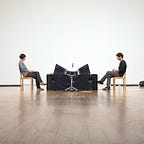Rooted to the earth, singing to the sky
Most of what we have written in these blog posts over the last year or so has been about our satellite-tracking process — antennas, software, satellite-pass monitoring, stuff like that. However, this process of receiving signals from the LES-1 satellite is just one half of Signal Tide.
Signal Tide has two sides. We’ve been referring to them, in our planning, as the ‘sky side’ and the ‘ground side’. Materially, the sky side will be a row of ten overhead speakers facing downwards, which will play the sound derived from the signal of the LES-1 satellite. We’ll have plenty more to say about that in future updates. But for now, we want to talk about the other half — the ground side.
Practically, the ground side of the installation is fairly straightforward — it will be a series of ten monitor speakers, arranged in two rows of five stereo pairs, with the two speakers in each pair facing towards each other, and also tilted upwards, towards the overhead speakers.
The sound that will be playing through these speakers needs a little explaining.
The LES-1 satellite was manufactured, in 1964, at Lincoln Laboratories, which is part of Massachusetts Institute of Technology (MIT), in Boston, Massachusetts. Lincoln Labs, and MIT generally, has a deserved reputation of being one of the best places in the world to work with, and study, advanced technologies.
At the same time, however, Boston, and the wider New England and Quebec area, is a region with a long and rich folk music tradition, comprising abundant overlapping threads of different types of music and song. One of these traditions is the folk practice of sacred harp singing. This is a culture of sacred choral music, sung in a cappella four-part harmonies. The name is derived from The Sacred Harp, a ubiquitous and significant tune-book printed in shape notes — an innovation that allows singers to participate without having received any formal musical education.
Sacred harp singing is an ongoing, living tradition, which originates from English religious music. In north America, it has two distinct schools, the ‘northern’ and ‘southern’ schools, which correspond roughly with the New England area (northern), and the American deep south (southern).
We have reconsidered this folk tradition as the basis for the music that will accompany the LES-1 in the final installation. The LES-1 satellite can be considered, anthropomorphically, as a weary pilgrim on a repeating journey, having left Boston in 1965 and travelled ever since. Signal Tide will thus allow the satellite to be serenaded with music derived from the place that it is originally from.
In order to have this music be part of the installation, we spent time earlier this year in Montréal, recording new interpretations of several sacred harp songs, collaborating with musicians and singers from Quebec and Massachusetts.
The main part of this work was undertaken in collaboration with David Bryant, guitarist of Godspeed You! Black Emperor and multi-instrumentalist in Hiss Tracts. Though David, we met Drew Barnet and James Hamilton, and together, we created versions of three different sacred harp songs: Fleeting Days, Funeral Anthem, and The Lone Pilgrim. Alongside this, we also created accompanying strands of sound recorded in parallel with the songs. As we started creating them, we began to refer to these experimental sound strands as ‘filaments’ — more on that soon.
We have uploaded excerpts from these recordings on SoundCloud. The mixes of these songs are preliminary until after we have first presented the work, so we are not yet uploading entire tracks. After presenting the finished installation and being able to fine-tune the sound, we’ll be able to share a lot more from these recording sessions.
The process of recording this music has been significant, and has involved many participants. They are:
- David Bryant
- Drew Barnet
- James Hamilton
- Sophie Trudeau
- Esther Wade
- Patrick DeDauw
- Xarah Dion
- Philippe Doyle-Gosselin
- Collin Findlay
- Elena Horgan
- Tim Eriksen
- Zoë Darrow
And, occasionally, us two: Kata Kovács and Tom O’Doherty.
As we were recording, mixing, listening to, and sifting-through all of this new music and sound, we also needed to think about how it would work to play the sound back in the installation. How could these individual filaments of sound be best presented? How could they be best combined with the fuller ‘composed’ versions that we had created, of these specific sacred harp songs? What way could they be presented that would best integrate them with the audio of the signal from the satellite overhead? This was something that required a lot of thought, and we want to talk about that in the next post.
